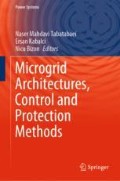Abstract
One of the most important issues in power grids is the outage problem that occurs due to weaknesses of the power system infrastructure or the occurrence of human or natural faults in the power system. The issue of complete deletion of power outages is unlikely due to unpredictable nature of major faults. After a fault, it is necessary to isolate the fault location as soon as possible. Thus, the energy path may be interrupted to some of the loads. However, new technologies or advanced methods can be used to reduce the interruptions duration. By appearance of smart grids and developing its level of intelligence, it is possible to automatically detect a fault in the shortest time, isolate it from the system and feed healthy parts of the system on a different path. The set of automatic activities that occur after a fault occurrence to achieve previous goals is called self-healing. In other words, Self-healing of the distribution system means changing the distribution network structure after fault in order to feed disconnected loads while maintaining the network’s electrical constraints. Undoubtedly, self-healing is one of the main abilities of the smart grids with respect to traditional systems to automatically retrieve system after fault occurrence or keep away system from critical conditions. Self-healing usually consists of three steps: fault location, isolation and system restoration (FLISR). The large number of lines, branches, and equipment of the distribution network can complicate this process. In this chapter, definition, requirements and challenges of self-healing are introduced and various approaches which have been recently proposed by researchers are assessed. Also some tools and methods like demand response, load shedding, distributed energy resources and autonomous microgrids which can facilitate self-healing process are assessed.
Access this chapter
Tax calculation will be finalised at checkout
Purchases are for personal use only
References
J. Popovic Gerber, J. Oliver, N. Cordero, T. Harder, J. Cobos, M. Hayes, S. O’Mathuna, E. Prem, Power electronics enabling efficient energy usage: energy savings potential and technological challenges. IEEE Trans. Power Electron. 27(5), 2338–2353 (2012)
C.P. Nguyen, Power System Voltage Stability and Agent Based Distribution Automation in Smart Grid. Illinois Institute of Technology (2011)
ERGEG, Position paper on smart grids. An ERGEG public consultation paper. Ref: E10-EQS-38-05 (2009)
M. Amin, Toward self-healing energy infrastructure systems. IEEE Comput. Appl. Power 14(1), 20–28 (2001)
U.S. EPRI, Methodological approach for estimating the benefits and costs of smart grid demonstration projects (2010)
M.A. Elgenedy, A.M. Masoud, S. Ahmed, Smart grid self-healing: functions, applications, and developments, in SGRE Conference, Qatar (2015)
S. Kazemi, M. Lehtonen, M. Fotuhi Firuzabad, Impacts of fault diagnosis schemes on distribution system reliability. IEEE Trans. Smart Grid 3(2), 720–727 (2012)
C. Sutar, K.S. Verma, A.S. Pandey, S.P Singh, Wide area measurement and control using phasor measurement unit in smart grid, in The 2nd IEEE International Conference on Power, Control and Embedded Systems (ICPCES), pp. 1–5 (2012)
L. Luo, N. Tai, G. Yang, Wide-area protection research in the smart grid. Energy Procedia 16, 1601–1606 (2012)
A. Ashok, A. Hahn, M. Govindarasu, Cyber-physical security of wide-area monitoring, protection and control in a smart grid environment. J. Adv. Res. 5(4), 481–489 (2014)
K.S.N. Singh Seethalekshmi, S.C. Srivastava, Wide-area protection and control: present status and key challenges, in The 15th National Power Systems Conference, Bombay, India, pp. 169–175 (2008)
M. Zarei, A. Zangeneh, Multi-objective optimization model for distribution network reconfiguration in the presence of distributed generations. Int. Trans. Electr. Energ. Syst. 27(12) (2017)
T. Caldognetto, P. Tenti, Microgrids operation based on master-slave cooperative control. IEEE J. Emerging Select. Top. Power Electron. 2(4), 1081–1088 (2014)
V. Hosseinnezhada, M. Rafieea, M. Ahmadiana, P. Sianob, A comprehensive framework for optimal day-ahead operational planning of self-healing smart distribution systems. Electr. Power Energy Syst. 99, 28–44 (2018)
M.H. Oboudi, R.A. Hooshmand, F. Faramarzi, M.J.A. Boushehri, Framework of intentional islanding operation of active distribution network based on selfhealing perspective. IET Renew. Power Gener. 12(2), 219–226 (2018)
S.A. Arefifar, Y.A. Mohamed, T.H. El Fouly, Comprehensive operational planning framework for self-healing control actions in smart distribution grids. IEEE Trans. Power Syst. 28(4), 4192–4200 (2013)
S.A. Arefifar, Y.A. Mohamed, T.H. El Fouly, Supply-adequacy-based optimal construction of microgrids in smart distribution systems. IEEE Trans. Smart Grid 3(3), 1491–1502 (2012)
S.S. Rao, Engineering Optimization: Theory and Practice (Wiley, Hoboken, 2009)
Z. Wang, J. Wang, Self-healing resilient distribution systems based on sectionalization into microgrids. IEEE Trans. Power Syst. 30(6), 3139–3149 (2015)
J. Li, X.Y. Ma, C.C. Liu, K.P. Schneider, Distribution system restoration with microgrids using spanning tree search. IEEE Trans. Power Syst. 29(6), 3021–3029 (2014)
S.B. Ghosn, P. Ranganathan, S. Salem, J. Tang, D. Loegering, K.E. Nygard, Agent-oriented designs for a self-healing smart grid, in First IEEE International Conference on Smart Grid Communications, pp. 461–466 (2010)
A. Zidan, E.F. El Saadany, A Cooperative multiagent framework self-healing mechanisms in distribution systems. IEEE Trans. Smart Grid 3(3), 1525–1539 (2012)
Author information
Authors and Affiliations
Corresponding author
Editor information
Editors and Affiliations
Rights and permissions
Copyright information
© 2020 Springer Nature Switzerland AG
About this chapter
Cite this chapter
Zangeneh, A., Moradzadeh, M. (2020). Self-healing: Definition, Requirements, Challenges and Methods. In: Mahdavi Tabatabaei, N., Kabalci, E., Bizon, N. (eds) Microgrid Architectures, Control and Protection Methods. Power Systems. Springer, Cham. https://doi.org/10.1007/978-3-030-23723-3_21
Download citation
DOI: https://doi.org/10.1007/978-3-030-23723-3_21
Published:
Publisher Name: Springer, Cham
Print ISBN: 978-3-030-23722-6
Online ISBN: 978-3-030-23723-3
eBook Packages: EnergyEnergy (R0)

